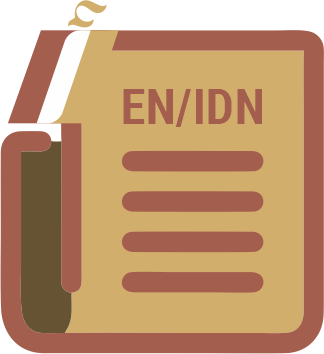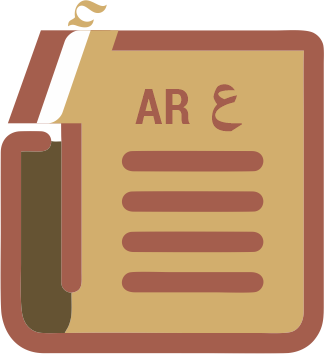THE ROLE OF DIGITAL DICTIONARY OF TRANSLATOR AR-ID IN MODERN ARABIC ERA SOCIETY 5.0
Abstract
The all-digital era of society 5.0 is considered a concept of society, centered on humans and based on technology. Progress in these various fields has given rise to many new vocabularies, of course a dictionary is needed to know and understand the meaning properly and correctly. Thus, the dictionary has a very important role in learning, especially the Arabic dictionary. Advances in technology, dictionaries are no longer in the form of sheets of paper, but are already in digital form which can be accessed with various media in the form of smartphones, laptops, tablets and so on. The purpose of this study is to reveal how the sources of the formation of modern Arabic and how the role of Translator AR-ID in interpreting new terms of modern Arabic in the era of society 5.0. This type of research is descriptive research using the Literature study. The results of this study reveal the sources of the formation of Modern Arabic consisting of Arabicization, Derivation, Arabicization and Derivation Preferences, Merger. One of the modern tools that can help translate Indonesian-Arabic is to use digital applications; digital dictionaries have an important role in translating new terms and vocabulary in modern Arabic. Because the digital dictionary always gets the latest updates regarding new words and meanings in every language, especially modern Arabic
Full Text:
PDFReferences
Abdullayeva, D. S. (2021) . The Importance Of Dictionary Instructions In Formulating Pragmatic And Language Competency Of Learners. The American Journal of Social Science and Education Innovations, 3(1), 268-274. DOI: https://doi.org/10.37547/tajssei/
Abdulsalam, K. A., Adebisi, J., Emezirinwune, M., & Babatunde, O. (2023). An Overview and Multicriteria Analysis of Communication Technologies for Smart Grid Applications. e-Prime - Advances in Electrical Engineering, Electronics and Energy. 3(1), 100-121. DOI: https://doi.org/10.1016/j.prime.
Agussalim, A. (2019). Perancangan Kamus Digital Linguistik-Arab Berbasis Windows dan Android. Nady Al-Adab Department of West Asian Studies, 16(2) 34–59.
Albantani, A. M., Fauziah, A. U., & Sumiantia, I. (2020). Perkembangan Kosakata Bahasa Arab Melalui Isytiqāq. ALSUNIYAT: Jurnal Penelitian Bahasa, Sastra, Dan Budaya Arab. 3(2) 1-14. DOI: https://doi.org/10.17509/alsuniyat.v3i2.26243
Aljasser, F., & Vitevitch, M. S. (2018). A Web-based Interface to Calculate Phonotactic Probability for Words and Nonwords in Modern Standard Arabic. Behavior Research 50(1), 313-322. DOI: https://doi.org/10.3758/s13428-017-0872-z
Alolaywi, Y. (2022). Derivation between English and Arabic with Reference to Translation: A Contrastive Analysis Study. Arab World English Journal For Translation and Literary Studies, 6 (3), 128-141. DOI: https://doi.org/10.24093/awejtls/vol6no3.9
Alshdaifat, A. (2021). The formation of verbs of emotion in Arabic. Jordan Journal of Modern Languages and Literatures, 13(1), 105-120. DOI: https://doi.org/10.47012/JJMLL.13.1.7
Ariati, S. (2022). The Use of an Android-Based Arabic Dictionary in the Arabic-Indonesian Tarjamah Course at the University, Industry and Higher Education, 1(1) 70-85.
Arifin, A., & Mulyani, S. (2021). Persepsi Mahasiswa Terhadap Penggunaan Kamus Digital Bahasa Arab Di Era Society 5.0. An Nabighoh. 23(2), 235-250. DOI: https://doi.org/10.32332/an-nabighoh.v23i2.4478
Asmara, H. D. (2019). Arabisasi (Ta’rib) Istilah-istilah Ilmiah dalam Buku Pelajaran Biologi Kelas 3 SMA, Alfaz (Arabic Literatures for Academic Zealots), 7(2) 1-12. DOI: https://doi.org/10.32678 /alfaz.vol7.iss02.2290
Azmi, H., Maulidiyah, I. W., Miftah, D., & Sutisna, F. (2018). Peran Kamus Digital Arab Bagi Mahasiswa Studi Arab Di Era 4.0., Multaqa Nasional Bahasa Arab, 1(1), 12-21.
Cai, J., Hadjinicolaou, A. E., Paulk, A. C., Williams, Z. M., & Cash, S. S. (2023). Natural Language Processing Models Reveal Neural Dynamics of Human Conversation. BioRxiv. DOI: doi10.1101/2023.03.10.531095
Che Mat, A., Ramli, N. A., Nokman, A. Z., Musilehat, N. S. B., & Abu Bakar, A. F. Bin. (2023). The Importance Of Idiomatic Dictionary In Arabic Language Acquisition: Students’ Perception. Ijaz Arabi Journal of Arabic Learning, 6(2). DOI: https://doi.org/10.18860/ijazarabi.v6i2.20562
Djuaeni, N. (2022). Isytiqaq dalam Pandangan Linguis Klasik dan Modern. JAEL : Journal of Arabic Education and Linguistic, 2(1), 11–19. DOI: https://doi.org/10.24252/jael.v2i1.31389
El Kbaich, A. T. (2023). Between Translation and Arabization: The Transmission of European Texts into Arabic during the Nahda. The case of al-Tahtāwī. Quaderns. 1(2) 92-106. DOI: https://doi.org/10.5565/rev/quaderns.107
Evi Nurus Suroiyah, & Dewi Anisatuz Zakiyah. (2021). Perkembangan Bahasa Arab Di Indonesia. Muhadasah: Jurnal Pendidikan Bahasa Arab, 3(1), 60–69. DOI: https://doi.org/10.51339/muhad.v3i1.302
Faidlatul Habibah, A., & Irwansyah, I. (2021). Era Masyarakat Informasi sebagai Dampak Media Baru. Jurnal Teknologi Dan Sistem Informasi Bisnis. 3(2) 350-363. DOI: https://doi.org/10.47233/jteksis.v3i2.255
Hanif, A., Deswita, D., Budiarti, M., Herman, H., Mudinillah, A., & Putri, L. R. (2023). Development of a Digital Dictionary for Measuring Arabic Language Education Students Retention. Migration Letters. 20(5), 321-339. DOI: https://doi.org/10.59670/ml.v20i5.3547
Haq, M. Z. (2022). Problematika Penerjemahan Idiomatik Arab Ke Indonesia. Muhibbul arabiyah: Jurnal Pendidikan Bahasa Arab, 2(1), 15-30. DOI: https://doi.org/10.35719/pba.v2i1.32
Hayani, F. (2019). Leksikografi Arab (Sebuah Kajian Linguistik Terapan). Shaut Al Arabiyyah. 7(1), 1-12. DOI: https://doi.org/10.24252/saa.v1i1.7786
Hilal, I. (2019). Creation of French Neologism in the Modern Arabic-French General Bilingual Dictionary. Lexikos, 20(1). DOI: https://doi.org/10.5788/29-1-1523
Hudaa, S., & Bahtiar, A. (2020). Variasi Bahasa Kaum Milenial: Bentuk Akronim dan Palindrom dalam Media Sosial. ESTETIK : Jurnal Bahasa Indonesia, 3(1), 42-52. DOI: https://doi.org/10.29240/estetik.v3i1.1470
Ibrahim, M. (2022). Al-Ta’ribat Mufradat Modern pada Lingkup IT (Analisis Leksikografi). Uktub: Journal of Arabic Studies, 2(1), 23-38.DOI: https://doi.org/10.32678/uktub.v2i1.6031
Keshav, M., Julien, L., & Miezel, J. (2022). The Role Of Technology In Era 5.0 In The Development Of Arabic Language In The World Of Education. Journal International of Lingua and Technology. 1(2), 79-98. DOI: https://doi.org/10.55849/jiltech.v1i2.85
Khalid, M. R. (2018). Al-ta'rib fi Al-Lughah Al-Arabiyah baina Al-Musyajji'in wa Al-Munkarin. Diwan : Jurnal Bahasa Dan Sastra Arab, 4(2), 98-113. DOI: https://doi.org/10.24252/diwan.v4i2.6703
Malik, A. (2009). Arabisasi (Ta’rib) dalam Bahasa Arab (Tinjauan Deskriptif-Historis). Adabiyyat, 8(2), 36. DOI: https://doi.org/10.14421/ajbs.2009.08204
Mohammed, I. F., & Dhayif, Q. A. (2022). Derivation and its Effect on Meaning in English and Arabic: A Contrastive Study. International Journal of Linguistics Studies, 2(2), 176-184. DOI: https://doi.org/10.32996/ijls.2022.2.2.20
Moleong, L. J. (2018). Metodologi Penelitian Kualitatif. PT Remaja Rosdakarya.
Murtosiah, S. (2020). Urgensi Bahasa Arab di Era 4.0. In Lughoti : Jurnal Pendidikan Bahasa Arab, 2(2), 49-66. DOI: https://doi.org/10.54396/saliha.v2i2.29
Niswah, I. (2018). Pola Derivasi Dalam Bahasa Arab. Al Lahjah, 2(2), 31–40.
Nugraha, A., & Aminur Rahman, F. (2021). Android Application Development of Student Learning Skills in Era Society 5.0. Journal of Physics: Conference Series. 17(1). DOI: https://doi.org/10.1088/1742-6596/1779/1/012014
Pansuri, H. (2018). Kamus Bahasa Arab: Cara Penggunaannya. Al-Ihda’: Jurnal Pendidikan Dan Pemikiran, 11(1), 112-120. DOI: https://doi.org/10.58645/alihda.v11i2
Rizqia, A. Q. S. Z., Maylana, A. N., & Luthfi, K. M. (2022). Arabic-Indonesian Dictionary: Comparison of Digital Dictionary and Printed Dictionary. Al-Ma‘Rifah, 19(1), 41–52. DOI: https://doi.org/10.21009/almakrifah.19.01.04
Satori, D., & Komariah, A. (2009). Metodologi Penelitian Kualitatif. Bandung: Alfabeta.
Society 5.0: A People-centric Super-smart Society. (2020). In Society 5.0: A People-centric Super-smart Society, 10(1), 1-18. DOI: https://doi.org/10.1007/978-981-15-2989-4
Sugiyono. (2018). Metode Penelitian Kuantitatif, Kualitatif, Dan R&D. Bandung: Alfabeta.
Taufiqurrochman, R. (2020). Advantages And Disadvantages Of Arabic Dictionary Applying Morphological System For Learning Arabic In Indonesia. LiNGUA: Jurnal Ilmu Bahasa Dan Sastra, 14 (2). DOI: https://doi.org/10.18860/ling.v14i2.8316
Taufiqurrochman, R., & Mustaqim, N. Y. S. (2023). Digital Indonesian Arabic Dictionary For Improving Mastery Of Arabic Vocabulary. Ijaz Arabi Journal of Arabic Learning. 6 (3), 669-681. DOI: https://doi.org/10.18860/ijazarabi.v6i3.22906
Tavares, M. C., Azevedo, G., & Marques, R. P. (2022). The Challenges and Opportunities of Era 5.0 for a More Humanistic and Sustainable Society, A Literature Review. Societies, 12(6), 1-21. DOI: https://doi.org/10.3390/soc12060149
Wargadinata, W., & Fitriani, L. (2008). Sastra Arab dan Lintas Budaya. Malang: UIN-Malang Press.
Yamin, M., Islam, U., Sultan, N., Idris, A. M., Annisa, S., Putri, M., Rohimah, S., Muhammad, A., Samarinda, I., Chairunnisa, S., Muhammad, S., & Chaidar, R. (2022). Kamus Digital Sebagai Sarana Hifdzul Mufrodah di Kelas VII-1 Madrasah Tsanawiyah Negeri Samarinda. Jurnal Tarbiyah & Ilmu Keguruan (JTIK) Borneo, 3(3), 37–45. DOI: https://doi.org/10.21093/sijope.v1i2.4917.
Zahrah, H., Wargadinata, W., & Barry, N. A. (2021). Analisis E-Dictionarry “Arab-Indonesia” yang Tersedia di Playstore dengan Pendekatan Leksikologi. Shaut Al Arabiyyah. 23(2), 235-250. DOI: https://doi.org/10.24252/saa.v9i1.21494
DOI: https://doi.org/10.18860/afshaha.v3i1.22902
Refbacks
- There are currently no refbacks.
Copyright (c) 2024 Afshaha: Jurnal Bahasa dan Sastra Arab

This work is licensed under a Creative Commons Attribution-ShareAlike 4.0 International License.
Member of:
Indexed by:
Editorial Office
Faculty of Humanities, Universitas Islam Negeri Maulana Malik Ibrahim Malang
Jalan Gajayana 50 Malang, Jawa Timur, Indonesia 65144
Phone (+62) 341 551354, Facsimile (+62) 341 572533
e-mail: afshaha@uin-malang.ac.id

Afshaha: Jurnal Bahasa dan Sastra Arab by Faculty of Humanities Universitas Islam Negeri Maulana Malik Ibrahim Malang is licensed under a Creative Commons Attribution-ShareAlike 4.0 International License.
View My Stats | Follow Us on Instagram
Afshaha: Jurnal Bahasa dan Sastra Arab, e-ISSN: 2963-9913








